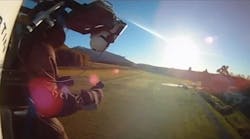New Zealand-based Martin Aircraft Co. currently is focused on developing the Martin Jetpack for use as a first responder vehicle and a heavy-lift unmanned air vehicle, but who knows how this invention might revolutionize working at heights.
Following the successful introduction of the Jetpack into the first responder community, the company will work on developing a jetpack for other uses such as leisure and personal use. Can fall protection be far behind?
The Martin Jetpack initially was conceived and developed by Glenn Martin in Christchurch, New Zealand in 1981 in response to another jetpack that had a one-minute flight-time limit. Now, over 30 years later, Martin Aircraft Co. has assembled a team of the best experts in aviation to make the jetpack a reality, with flight capability of over 30 minutes at speeds up to 74 km/h (60 mph) and altitudes above 800 feet.
Safety Features
According to promotional materials, safety has been a key consideration in all aspects of the development of the Martin Jetpack. “We look to enhance safety through design, manufacture, training, operations and dedicated safety systems,” says the company on its web site. Safety features include:
Simplicity of design – The design of the jetpack has been kept as simple as possible. There is a low overall component count, which aids reliability and overall safety.
Ducted fan – The use of ducted fans has a fundamental safety advantage over propellers and rotors. The tips of the blades are contained within the duct and are less of a safety hazard than exposed blades. This makes it safer for people near the aircraft, and reduces the risk of damage due to propellers or rotors coming into contact with objects.
See a video gallery of Martin Jetpack flights.
Ease of flight – A key component of aircraft safety comes from the ease of flight. The jetpack flight control system is computer controlled and stabilized. With the current software load, if the controls are released during flight, the Jetpack achieves and maintains an upright attitude and maintains height (enters a hover). During normal operations the system automatically maintains the desired height during maneuvers.
Pilot protection – The pilot is protected by the pilot module and the structure of the jetpack. The pilot module includes a rollover bar, frontal protection and arm restraint. The structure of the jetpack provides protection to the pilot from the rear and side, and the landing gear provides protection from below.
Parachute – A key safety system is the parachute system. This is a ballistic parachute system, with ballistic extraction and inflation of the chute. This leads to very quick chute opening, which enables the pilot to be saved in the case of a catastrophic failure down to a low height.
Coming to Market Soon
The jetpack could be available this year, and is expected to sell for approximately NZ$150,000, with the first production model aimed at military and first responders, but a more basic model for the general public may be on the market as early as 2015.
Which has some safety people thinking…
“This is the by far the greatest fall protection invention since the harness and lanyard,” said Carl W. Heinlein, CSP, OHST, ARM, senior safety consultant for the American Contractors Insurance Group. “The new jet pack offers an endless array of production, quality, safety and profitability opportunities.”
Heinlein went on to add, “The first contractors to implement this technology will have a major competitive advantage. I can't wait to try one out!”
“Wish I’d thought of that,” groused the president of the fall protection division of a major personal protective equipment manufacturer. “Buzz Lightyear is my favorite movie character!”
(Special thanks to Carl Heinlein for his participation in this April Fools Day article. Editor's Note: The Martin Jetpack is a real product which will be coming to market this year. As far as we know, the company has no intention of promoting it for use as a fall protection device, though maybe they should!)

